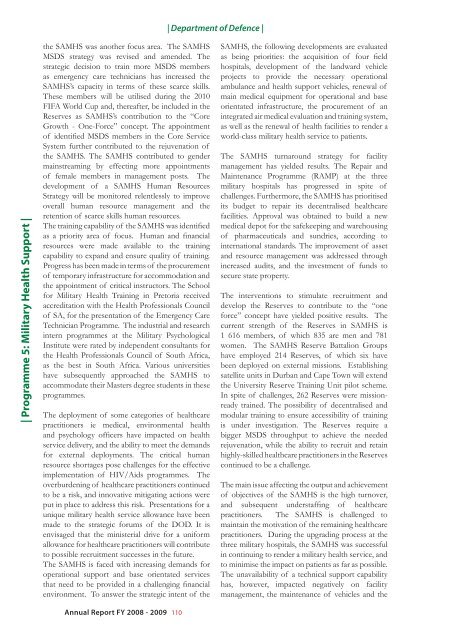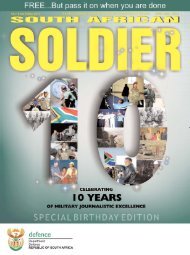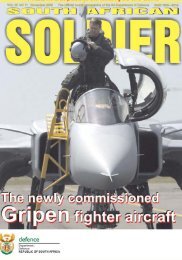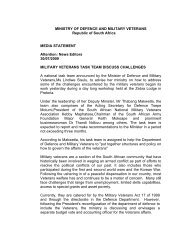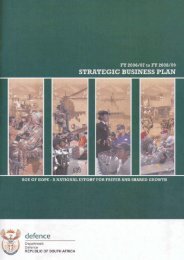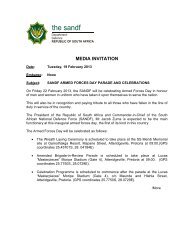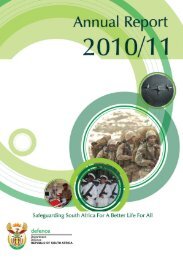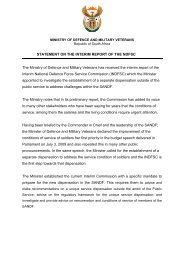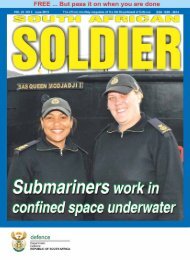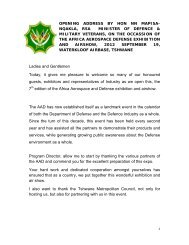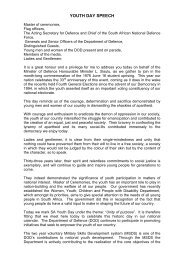Department of Defence Annual Report 2008-2009
Department of Defence Annual Report 2008-2009
Department of Defence Annual Report 2008-2009
- No tags were found...
Create successful ePaper yourself
Turn your PDF publications into a flip-book with our unique Google optimized e-Paper software.
| <strong>Department</strong> <strong>of</strong> <strong>Defence</strong> |<br />
| Programme 5: Military Health Support |<br />
the SAMHS was another focus area. The SAMHS<br />
MSDS strategy was revised and amended. The<br />
strategic decision to train more MSDS members<br />
as emergency care technicians has increased the<br />
SAMHS’s capacity in terms <strong>of</strong> these scarce skills.<br />
These members will be utilised during the 2010<br />
FIFA World Cup and, thereafter, be included in the<br />
Reserves as SAMHS’s contribution to the “Core<br />
Growth - One-Force” concept. The appointment<br />
<strong>of</strong> identied MSDS members in the Core Service<br />
System further contributed to the rejuvenation <strong>of</strong><br />
the SAMHS. The SAMHS contributed to gender<br />
mainstreaming by effecting more appointments<br />
<strong>of</strong> female members in management posts. The<br />
development <strong>of</strong> a SAMHS Human Resources<br />
Strategy will be monitored relentlessly to improve<br />
overall human resource management and the<br />
retention <strong>of</strong> scarce skills human resources.<br />
The training capability <strong>of</strong> the SAMHS was identied<br />
as a priority area <strong>of</strong> focus. Human and nancial<br />
resources were made available to the training<br />
capability to expand and ensure quality <strong>of</strong> training.<br />
Progress has been made in terms <strong>of</strong> the procurement<br />
<strong>of</strong> temporary infrastructure for accommodation and<br />
the appointment <strong>of</strong> critical instructors. The School<br />
for Military Health Training in Pretoria received<br />
accreditation with the Health Pr<strong>of</strong>essionals Council<br />
<strong>of</strong> SA, for the presentation <strong>of</strong> the Emergency Care<br />
Technician Programme. The industrial and research<br />
intern programmes at the Military Psychological<br />
Institute were rated by independent consultants for<br />
the Health Pr<strong>of</strong>essionals Council <strong>of</strong> South Africa,<br />
as the best in South Africa. Various universities<br />
have subsequently approached the SAMHS to<br />
accommodate their Masters degree students in these<br />
programmes.<br />
The deployment <strong>of</strong> some categories <strong>of</strong> healthcare<br />
practitioners ie medical, environmental health<br />
and psychology <strong>of</strong>cers have impacted on health<br />
service delivery, and the ability to meet the demands<br />
for external deployments. The critical human<br />
resource shortages pose challenges for the effective<br />
implementation <strong>of</strong> HIV/Aids programmes. The<br />
overburdening <strong>of</strong> healthcare practitioners continued<br />
to be a risk, and innovative mitigating actions were<br />
put in place to address this risk. Presentations for a<br />
unique military health service allowance have been<br />
made to the strategic forums <strong>of</strong> the DOD. It is<br />
envisaged that the ministerial drive for a uniform<br />
allowance for healthcare practitioners will contribute<br />
to possible recruitment successes in the future.<br />
The SAMHS is faced with increasing demands for<br />
operational support and base orientated services<br />
that need to be provided in a challenging nancial<br />
environment. To answer the strategic intent <strong>of</strong> the<br />
SAMHS, the following developments are evaluated<br />
as being priorities: the acquisition <strong>of</strong> four eld<br />
hospitals, development <strong>of</strong> the landward vehicle<br />
projects to provide the necessary operational<br />
ambulance and health support vehicles, renewal <strong>of</strong><br />
main medical equipment for operational and base<br />
orientated infrastructure, the procurement <strong>of</strong> an<br />
integrated air medical evaluation and training system,<br />
as well as the renewal <strong>of</strong> health facilities to render a<br />
world-class military health service to patients.<br />
The SAMHS turnaround strategy for facility<br />
management has yielded results. The Repair and<br />
Maintenance Programme (RAMP) at the three<br />
military hospitals has progressed in spite <strong>of</strong><br />
challenges. Furthermore, the SAMHS has prioritised<br />
its budget to repair its decentralised healthcare<br />
facilities. Approval was obtained to build a new<br />
medical depot for the safekeeping and warehousing<br />
<strong>of</strong> pharmaceuticals and sundries, according to<br />
international standards. The improvement <strong>of</strong> asset<br />
and resource management was addressed through<br />
increased audits, and the investment <strong>of</strong> funds to<br />
secure state property.<br />
The interventions to stimulate recruitment and<br />
develop the Reserves to contribute to the “one<br />
force” concept have yielded positive results. The<br />
current strength <strong>of</strong> the Reserves in SAMHS is<br />
1 616 members, <strong>of</strong> which 835 are men and 781<br />
women. The SAMHS Reserve Battalion Groups<br />
have employed 214 Reserves, <strong>of</strong> which six have<br />
been deployed on external missions. Establishing<br />
satellite units in Durban and Cape Town will extend<br />
the University Reserve Training Unit pilot scheme.<br />
In spite <strong>of</strong> challenges, 262 Reserves were missionready<br />
trained. The possibility <strong>of</strong> decentralised and<br />
modular training to ensure accessibility <strong>of</strong> training<br />
is under investigation. The Reserves require a<br />
bigger MSDS throughput to achieve the needed<br />
rejuvenation, while the ability to recruit and retain<br />
highly-skilled healthcare practitioners in the Reserves<br />
continued to be a challenge.<br />
The main issue affecting the output and achievement<br />
<strong>of</strong> objectives <strong>of</strong> the SAMHS is the high turnover,<br />
and subsequent understafng <strong>of</strong> healthcare<br />
practitioners. The SAMHS is challenged to<br />
maintain the motivation <strong>of</strong> the remaining healthcare<br />
practitioners. During the upgrading process at the<br />
three military hospitals, the SAMHS was successful<br />
in continuing to render a military health service, and<br />
to minimise the impact on patients as far as possible.<br />
The unavailability <strong>of</strong> a technical support capability<br />
has, however, impacted negatively on facility<br />
management, the maintenance <strong>of</strong> vehicles and the<br />
<strong>Annual</strong> <strong>Report</strong> FY <strong>2008</strong> - <strong>2009</strong> 110


